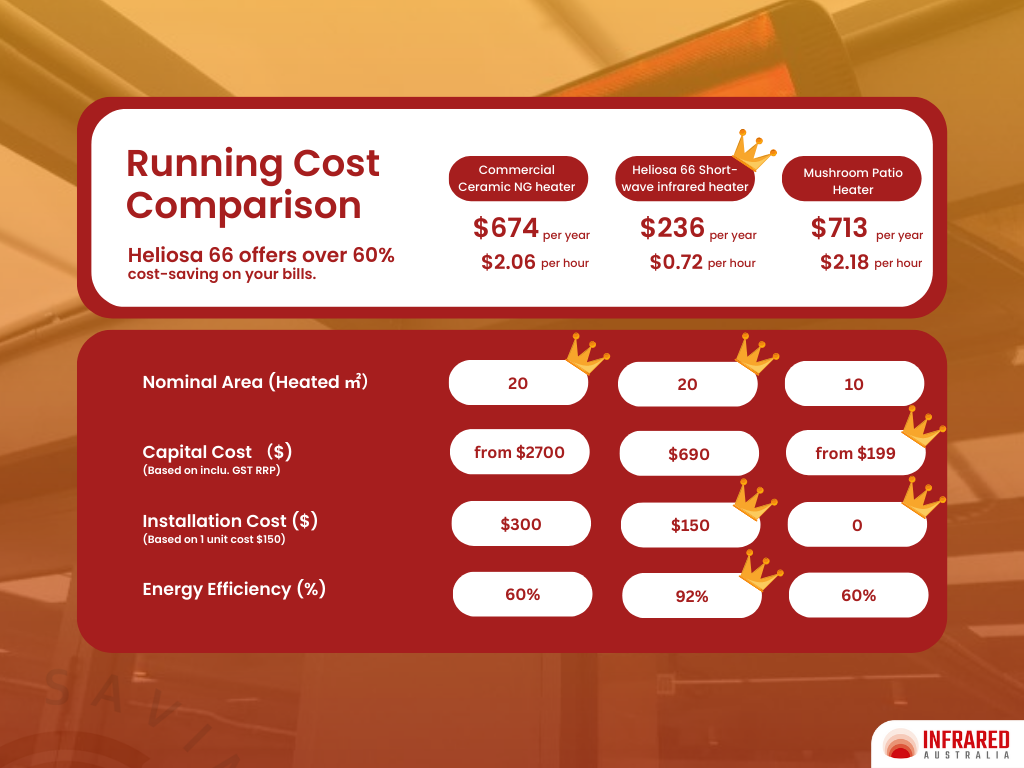As we become increasingly aware of the impact of carbon emissions on the environment, it’s essential to consider more sustainable and eco-friendly heating solutions. In this article, we will discuss two heating options – gas space heating and short-wave infrared heating – and compare their efficiency, running costs, and environmental impact. While a gas heater is still the primary choice for outdoor and industrial space heating, infrared heating – especially short-wave infrared heating – is a viable alternative that provides targeted, instant heat and reduces energy loss to the atmosphere. We will also explore the cost savings from switching to short-wave infrared heating and the Australian government’s grants and incentives for transitioning away from emission heavy gas.
The most efficient patio heating option on the market – Short-wave infrared heating
“Infrared heater” is a term widely used by manufacturers of radiant heaters, but not all infrared heaters are the same. The majority of infrared heaters use ‘long-wave infrared’ (e.g. panel heaters) or ‘medium-wave infrared’ (e.g. carbon element heaters) to warm areas.

All gas patio heaters, whether fixed natural gas or LPG bottle gas, fall into the ‘medium-wave infrared’ range. Gas tube heaters fall into the ‘long-wave infrared’ range. So even compared to fixed gas heating products, short-wave infrared is still the most efficient outdoor and industrial heating option on the market.
Low carbon intensity, sustainable heating solutions for homes and businesses
If you choose to heat an outdoor area or a large indoor open space, short-wave infrared heating is the most eco-friendly option. Short-wave is naturally absorbed by humans, providing a fresher type of heat. It is instant and targeted so only heats what needs to be heated.
However, gas heating is still the main choice for outdoor, factory and warehouse space heating for 70% of Australian families and businesses. Increasingly, we all understand that this generates high carbon emissions and causes negative impacts on the climate. Unvented gas heating is also a health hazard and why most States ban this form of heating from being used indoors; those same emissions are allowed outdoors in large open areas due to air movement, but this doesn’t mean that there is no exposure to the pollutants.
The Australian government is encouraging a transition from gas-based heating to electric heating to meet emissions reduction targets of 43% by 2030 and achieve net-zero emissions by 2050. Switching to electric infrared heating is considered a significant solution to meet energy targets.

To support this transition, Federal and State governments offers various funds to help individuals and businesses improve their energy efficiency. You can find more information about grants for electric heating upgrades for your projects or homes at Government Grants – Green Initiatives. You may also discover other assistance at a local government level.
How much you can save if switching to short-wave infrared heaters from gas heating?
Cost comparisons can be made between various forms of heating using manufacturer’s data and publically available energy costs. We have compared running natural gas / LPG heaters with our Heliosa short-wave infrared heaters, including estimates for installation to work out the heating costs differences.
In making our comparisons, we have assumed 327 hours a year of usage (three winter months at 3 hours a day, 7 days a week, plus two shoulder months at 2 hours a day, 3 days a week) which matches the typical usage pattern of a hospitality venue. These are estimates and each installation needs to take its own circumstances and usage patterns into account. We recognise that residential usage patterns are likely different and less than this amount of hours, while factory and warehouse usage would likely be different and greater.

*Comparison above is based on South Australia costs as of January 2023 from the average usage rates of leading retailers, both gas and electricity. Click here to access the full comparison figure.
The results of our comparison show that while a portable mushroom patio heater is still the cheapest product to buy, it only takes one year (based on the example usage) for the balance to shift due to running costs. The results also show that short-wave infrared heaters like Heliosa are the cheapest heating option to run in the winter, with only one-third of the conventional gas heating cost.
In addition, as we have identified earlier, gas patio heating is medium-wave infrared, and so the nominal heated area is not an accurate reflection of the effective heated area. For example, a mushroom heater is lucky to heat 6m² metres, despite claims of 10 – 17m², so you really need two to match the effective heating area of one Heliosa 66 alfresco heater.
Overall, the case is there for the replacement of climate-damaging gas outdoor heating and industrial gas heating with the space heating technology of today and tomorrow – join the movement away from gas and towards short-wave infrared heating.
Want to customize a heating layout plan for your space?
Get in touch with us via email at [email protected] or call (08) 7122 1114, and our team will help you to find out the best solutions.
Want to know more about our infrared heater via practical applications?
Please access our case studies to learn more about Heliosa infrared heater use in stylish homes & hospitality venues. You can experience our heaters at a location near you.
Follow Us On Social Media:
